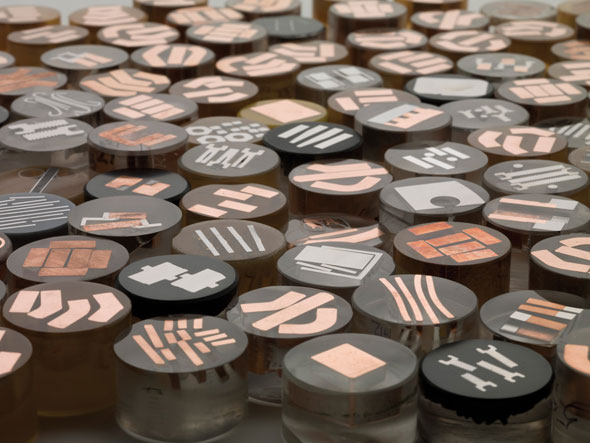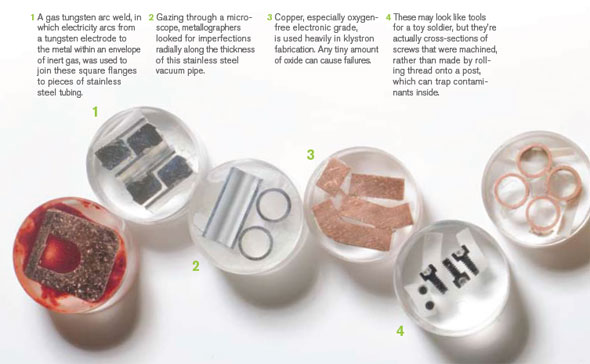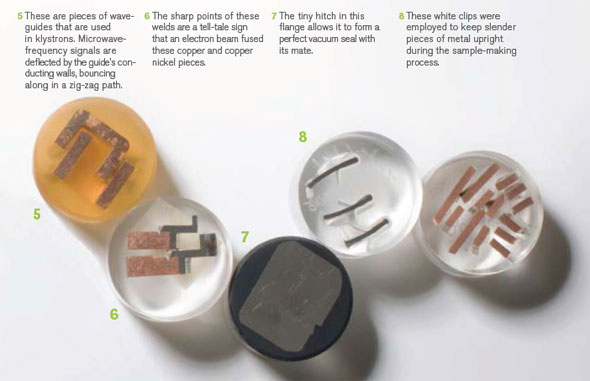Gallery: Accidental beauties
These exquisite test samples transcend their original purpose—ensuring all the metal parts of SLAC accelerators and detectors are flawless.
By Lauren Schenkman
 |
| Photos: Reidar Hahn, Fermilab |
There is something undeniably appealing about these baubles, which were rescued by the boxful from the salvage yard at SLAC National Accelerator Laboratory. Each gemlike piece is at once simple, playful, and eloquent. One resembles an assortment of minuscule wrenches, another a face cracking a geometric grin. They seem to mean or symbolize something, to tell a tale in their glint and sparkle. Each one is unique, and uniquely compelling. But what are they?
The answer, it turns out, is everything.
Every project that came through SLAC sent stuff through us, says former SLAC metallographer Will Glesener. Now a metallurgist with a company in New York, Glesener spent five years at SLAC inspecting the quality of materials that eventually found their way into particle detectors and accelerators. He would take snippets of every batch of metal SLAC purchased, whether it came from the United States, Finland, or Japan, and process them into these metallographic mounts, which he then examined under a microscope.
To the trained eye of a klystron engineer or accelerator physicist, the tiny wrenches become machined screws, a zigzag of copper and stainless steel becomes an electron-beam weld, two eyes and a nose become vacuum tubing.
 |
Finer and finer
Crafting a mount is an art, a meticulous process with many steps. It usually took, from start to finish, a couple of days for the whole procedure, Glesener says. To sample a bar of copper, he would slice off a small chunk with a diamond saw, place it in an epoxy mold, and bake it at high temperature and pressure. Then hed begin the slow, painstaking work of polishing the samples surface with five different grit sizes, then with three progressively finer grades of diamond slurry, and finally an incredibly fine 0.05 micrometer alumina polish that left the surface as smooth as a mirror. Then Glesener would dab the mount with a cotton swab dipped in an etching chemical, removing the smooth layer, and the sample would be ready for viewing.
It was very time consuming, but the whole purpose was to get beyond this and then look at the microstructure, which is what youre after. Then the story begins, says Jean Francis, who began working as a metallographer at SLAC in 1964, during the early days of accelerator construction. After all the heating, pounding, and cutting, the challenge is to maintain what was done to [the metal], without altering the story.
In her 40 years at SLAC, Francis made thousands of samples, inspecting the raw materials for components ranging from the original accelerator cavities to flanges for the B-meson factory of the late 1990s. Viewing the samples through a specialized microscope called a metallograph, Francis could read the tale of a poorly executed braze or a flawless vacuum tube. She especially loved looking at extremely pure copper, whose microstructure held the story of the smelting and extraction processes.
Copper to me is prettier than gold, says Francis, who now lives in rural Utah. It has this pink cast to it. The purity that we were handling was outstanding, and I always remember that this is not what the material was before extraction from nature. To think of the process this material went through, she says, is truly a wonder.
 |
Tiny flaws, big trouble
Smelting processes for copper can go slightly awry. Gazing into the microscope, Francis and Glesener hunted for specks of copper oxide in a landscape resembling an aerial view of a desert crossed by one or two lonely highways, boundary lines dividing different grains in the metal. Impurities like these can lead to electric arcing, which causes the copper to warp and melt, undermining the performance of klystrons, the devices that feed microwave-frequency power into the linear accelerator.
The klystrons are the pulse of the linear accelerator, so there was really critical analysis done, Glesener says. What we were actually looking for was oxygen contamination down in the parts per million.
Accelerator and klystron components are joined by brazing, in which two parts are placed in a furnace with a filler metal that has a lower melting point. The metal melts and capillary action pulls it into the gap between the two components; removed from the furnace, the metal cools and hardens. But when contaminated copper parts are brazed together in a hydrogen furnace, hydrogen can seep into the copper to join trapped oxygen, forming water vapor.
If you have enough it will turn it into Swiss cheese, and it no longer meets the requirements of being a nice vacuum material, says Erik Jongewaard, head of SLACs klystron department.
Pieces of lab history
As they worked, the metallographers scratched a code of letters and numbers into the back of each mount, and kept the matching reports and images in black D-ring binders.
We kept all the mounts from day one, so we could pull out a mount and retest it, Glesener says. Ive had a request from the klystron department where a part they put in 20 years ago broke, and they wanted to test the material that part was made of. The trays of gleaming mounts were also a popular attraction on lab tours.
When major budget cuts shook SLAC in January 2008, the Surface and Materials Science department, of which metallurgy was a part, was closed and the work contracted out. The department head tried to save as much of the scientific equipment as possible, but the large collection of mounts went to salvage. Although most have been lost, the survivors have found a new home in the SLAC archives.
The metallographic mounts are part of the physical record of the laboratorys history, and a testament to the incredible challenges that were overcome in building such large-scale experiments. As Francis puts it, peering through a microscope at these samples was a first-hand glimpse of man trying to do the impossible.
Click here to download the pdf version of this article.






